Critical Evaluation of Project Management Planning Tools: WBS & Gantt
VerifiedAdded on 2023/06/10
|11
|1960
|337
Essay
AI Summary
This essay provides a critical analysis of project management planning tools, focusing on Work Breakdown Structure (WBS) and Gantt charts. It begins with an introduction to project management and the role of these tools in organizing work and managing tasks. The essay then delves into a detailed explanation of WBS, highlighting its use in breaking down projects into manageable units, and Gantt charts, emphasizing their utility in scheduling and resource allocation. A thorough analysis and critique section discusses the strengths and limitations of each tool, such as WBS preventing work slippage and Gantt charts enhancing team motivation, while also addressing drawbacks like WBS's step-by-step approach and Gantt charts' dependency on WBS. The essay concludes by comparing the two tools and underscoring their importance in project management, particularly in scheduling and estimating project timelines, noting that Desklib offers additional resources for students seeking further assistance.
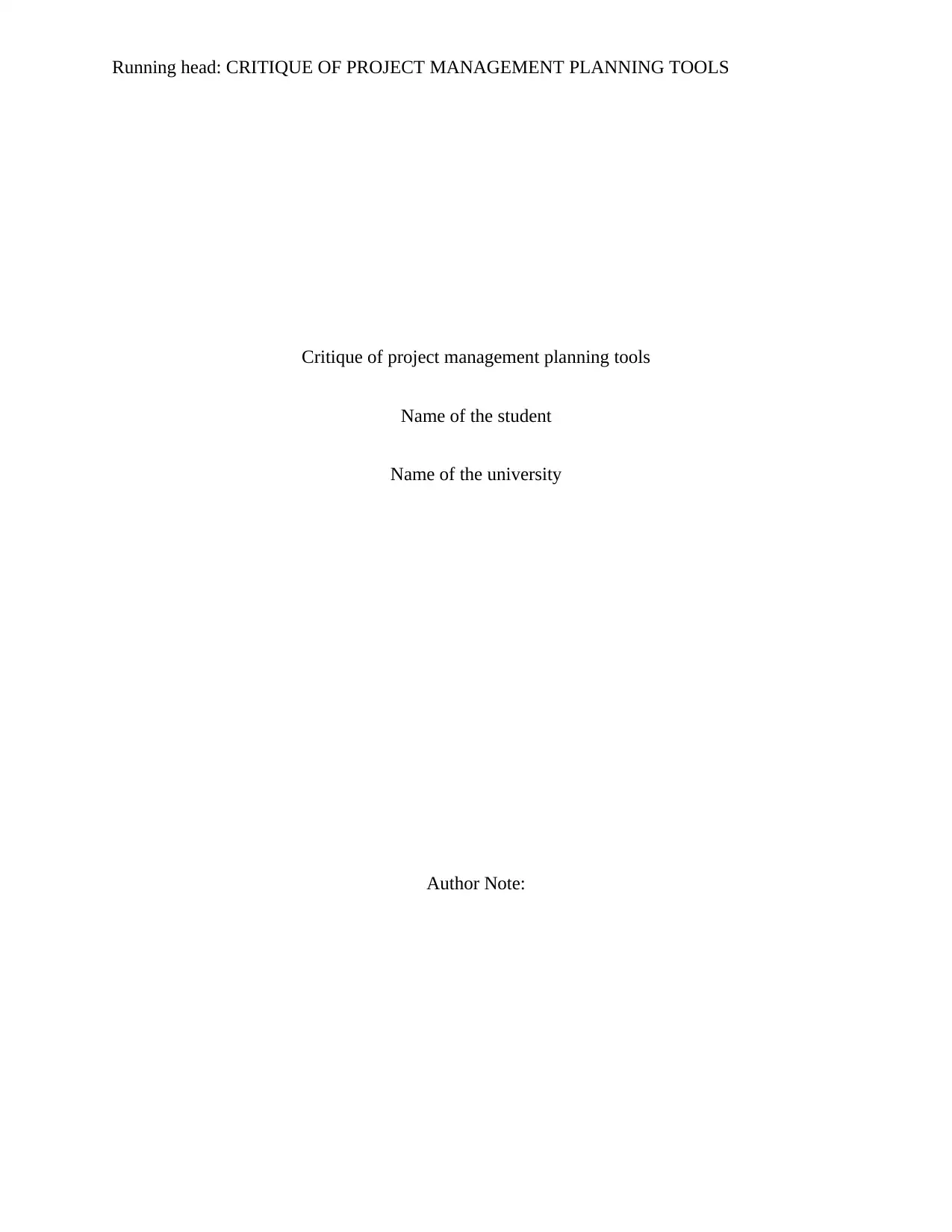
Running head: CRITIQUE OF PROJECT MANAGEMENT PLANNING TOOLS
Critique of project management planning tools
Name of the student
Name of the university
Author Note:
Critique of project management planning tools
Name of the student
Name of the university
Author Note:
Secure Best Marks with AI Grader
Need help grading? Try our AI Grader for instant feedback on your assignments.
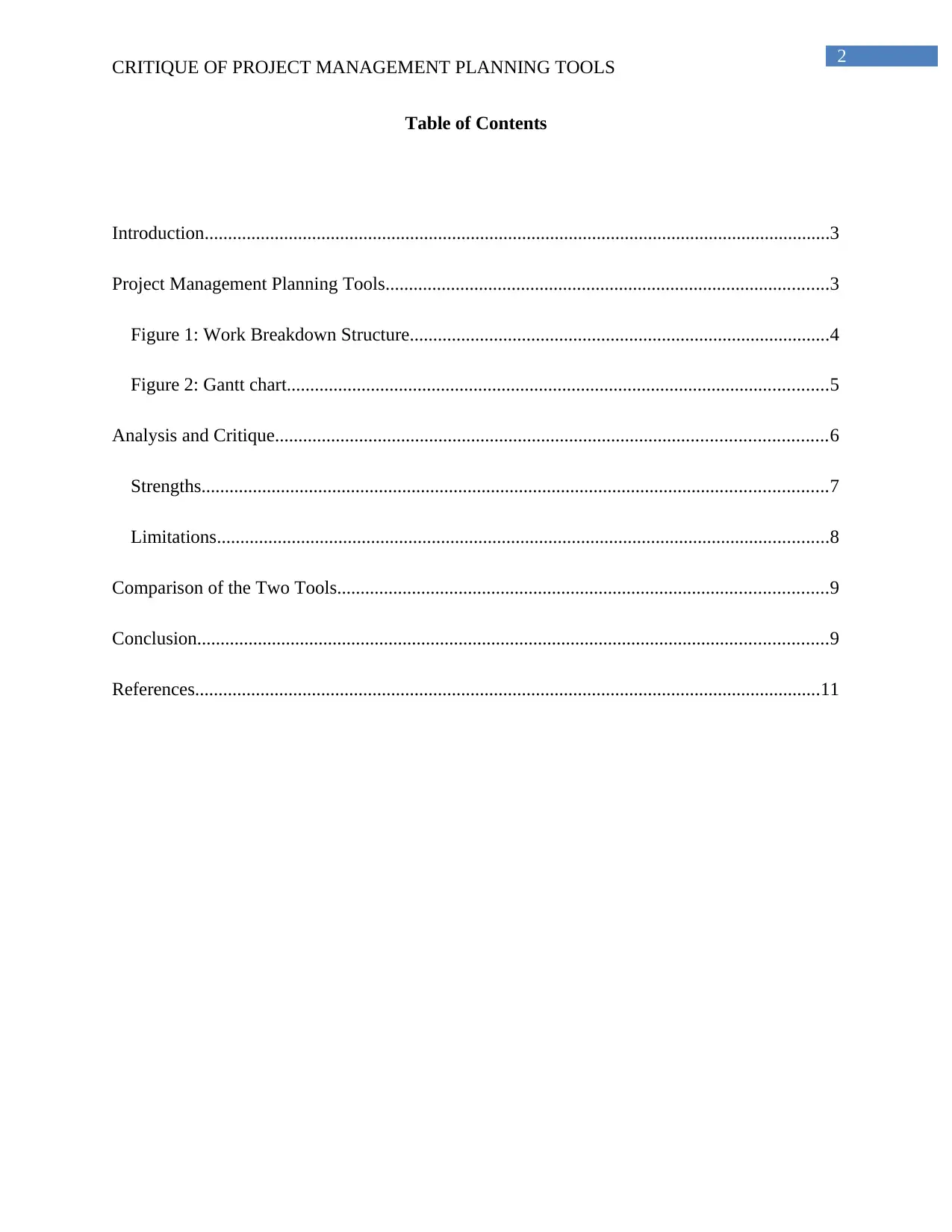
2
CRITIQUE OF PROJECT MANAGEMENT PLANNING TOOLS
Table of Contents
Introduction......................................................................................................................................3
Project Management Planning Tools...............................................................................................3
Figure 1: Work Breakdown Structure..........................................................................................4
Figure 2: Gantt chart....................................................................................................................5
Analysis and Critique......................................................................................................................6
Strengths......................................................................................................................................7
Limitations...................................................................................................................................8
Comparison of the Two Tools.........................................................................................................9
Conclusion.......................................................................................................................................9
References......................................................................................................................................11
CRITIQUE OF PROJECT MANAGEMENT PLANNING TOOLS
Table of Contents
Introduction......................................................................................................................................3
Project Management Planning Tools...............................................................................................3
Figure 1: Work Breakdown Structure..........................................................................................4
Figure 2: Gantt chart....................................................................................................................5
Analysis and Critique......................................................................................................................6
Strengths......................................................................................................................................7
Limitations...................................................................................................................................8
Comparison of the Two Tools.........................................................................................................9
Conclusion.......................................................................................................................................9
References......................................................................................................................................11
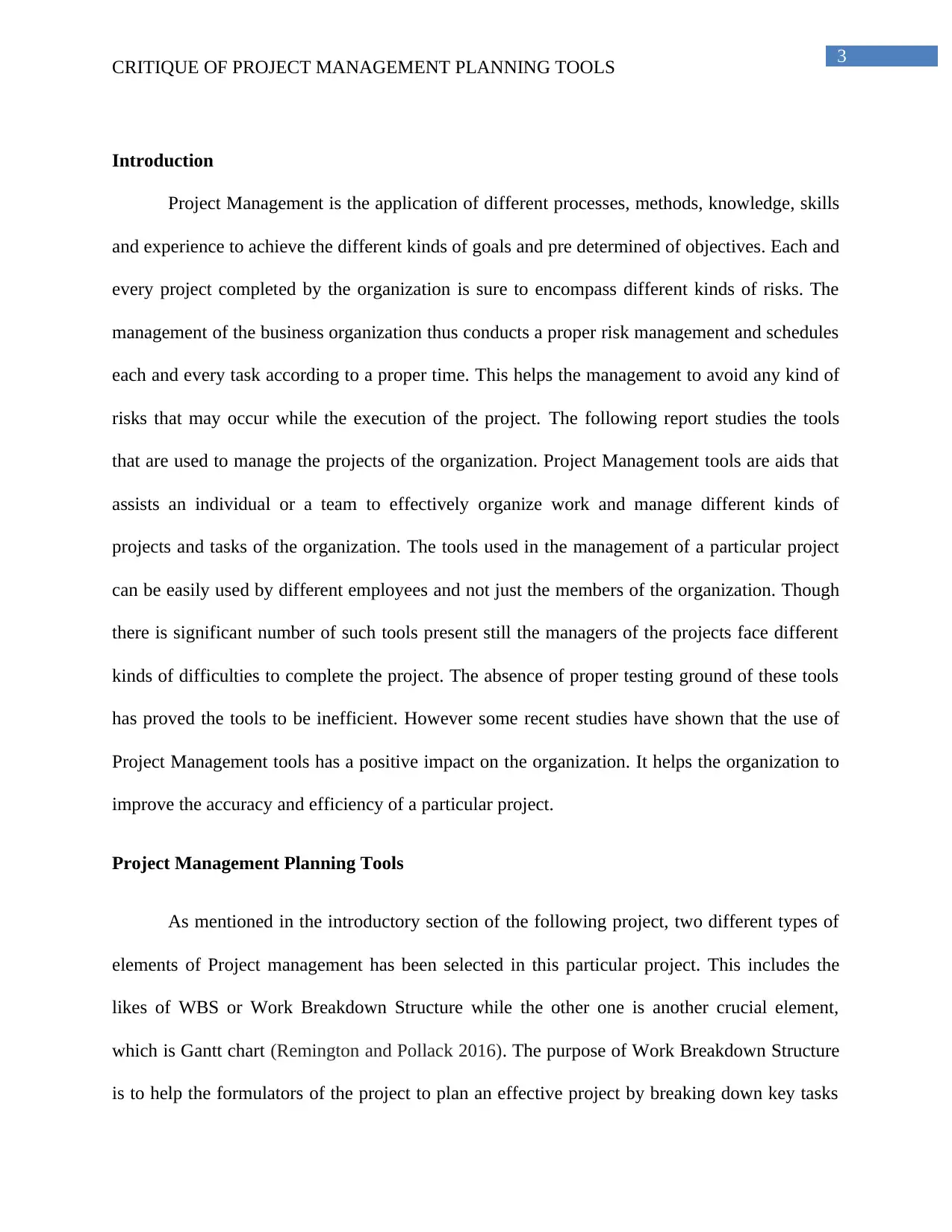
3
CRITIQUE OF PROJECT MANAGEMENT PLANNING TOOLS
Introduction
Project Management is the application of different processes, methods, knowledge, skills
and experience to achieve the different kinds of goals and pre determined of objectives. Each and
every project completed by the organization is sure to encompass different kinds of risks. The
management of the business organization thus conducts a proper risk management and schedules
each and every task according to a proper time. This helps the management to avoid any kind of
risks that may occur while the execution of the project. The following report studies the tools
that are used to manage the projects of the organization. Project Management tools are aids that
assists an individual or a team to effectively organize work and manage different kinds of
projects and tasks of the organization. The tools used in the management of a particular project
can be easily used by different employees and not just the members of the organization. Though
there is significant number of such tools present still the managers of the projects face different
kinds of difficulties to complete the project. The absence of proper testing ground of these tools
has proved the tools to be inefficient. However some recent studies have shown that the use of
Project Management tools has a positive impact on the organization. It helps the organization to
improve the accuracy and efficiency of a particular project.
Project Management Planning Tools
As mentioned in the introductory section of the following project, two different types of
elements of Project management has been selected in this particular project. This includes the
likes of WBS or Work Breakdown Structure while the other one is another crucial element,
which is Gantt chart (Remington and Pollack 2016). The purpose of Work Breakdown Structure
is to help the formulators of the project to plan an effective project by breaking down key tasks
CRITIQUE OF PROJECT MANAGEMENT PLANNING TOOLS
Introduction
Project Management is the application of different processes, methods, knowledge, skills
and experience to achieve the different kinds of goals and pre determined of objectives. Each and
every project completed by the organization is sure to encompass different kinds of risks. The
management of the business organization thus conducts a proper risk management and schedules
each and every task according to a proper time. This helps the management to avoid any kind of
risks that may occur while the execution of the project. The following report studies the tools
that are used to manage the projects of the organization. Project Management tools are aids that
assists an individual or a team to effectively organize work and manage different kinds of
projects and tasks of the organization. The tools used in the management of a particular project
can be easily used by different employees and not just the members of the organization. Though
there is significant number of such tools present still the managers of the projects face different
kinds of difficulties to complete the project. The absence of proper testing ground of these tools
has proved the tools to be inefficient. However some recent studies have shown that the use of
Project Management tools has a positive impact on the organization. It helps the organization to
improve the accuracy and efficiency of a particular project.
Project Management Planning Tools
As mentioned in the introductory section of the following project, two different types of
elements of Project management has been selected in this particular project. This includes the
likes of WBS or Work Breakdown Structure while the other one is another crucial element,
which is Gantt chart (Remington and Pollack 2016). The purpose of Work Breakdown Structure
is to help the formulators of the project to plan an effective project by breaking down key tasks
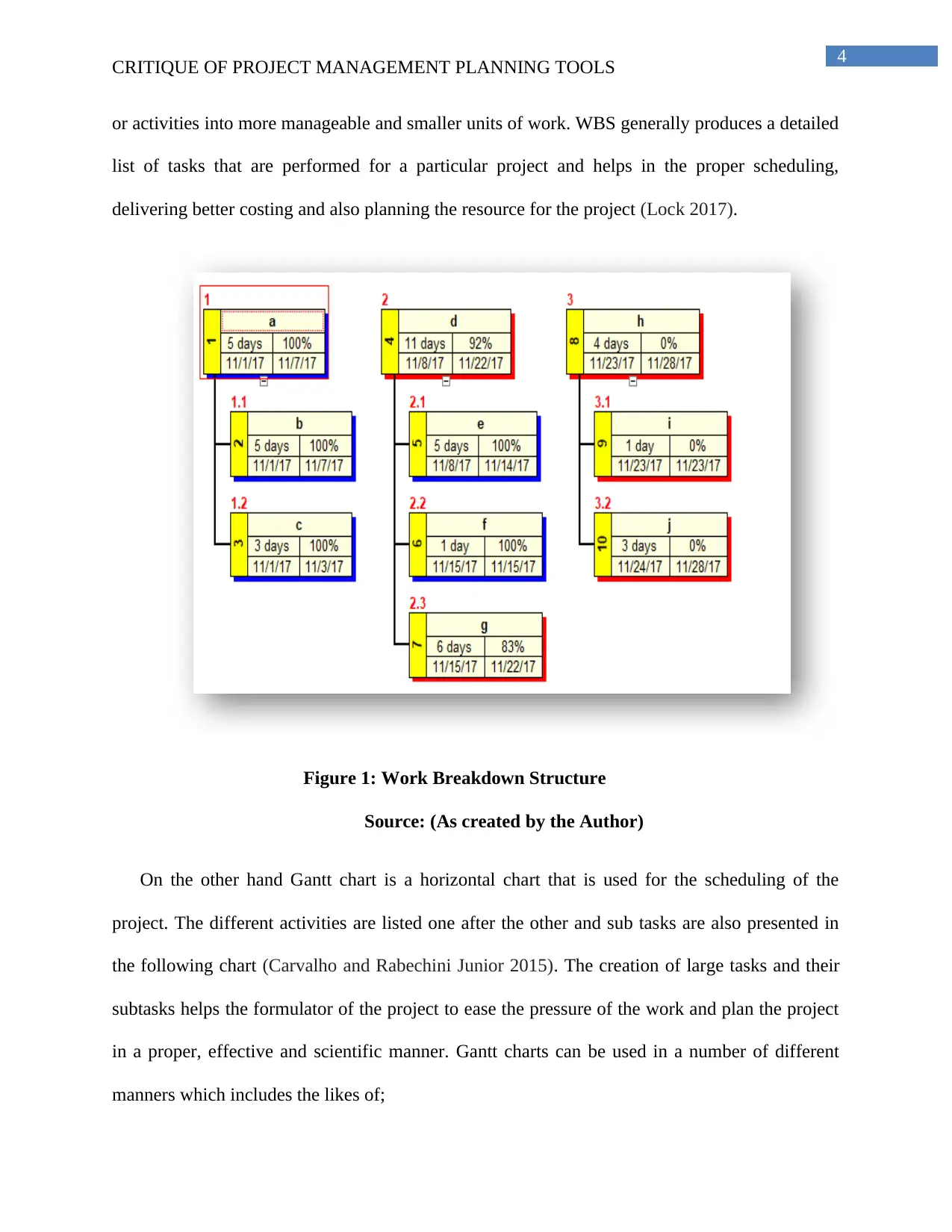
4
CRITIQUE OF PROJECT MANAGEMENT PLANNING TOOLS
or activities into more manageable and smaller units of work. WBS generally produces a detailed
list of tasks that are performed for a particular project and helps in the proper scheduling,
delivering better costing and also planning the resource for the project (Lock 2017).
Figure 1: Work Breakdown Structure
Source: (As created by the Author)
On the other hand Gantt chart is a horizontal chart that is used for the scheduling of the
project. The different activities are listed one after the other and sub tasks are also presented in
the following chart (Carvalho and Rabechini Junior 2015). The creation of large tasks and their
subtasks helps the formulator of the project to ease the pressure of the work and plan the project
in a proper, effective and scientific manner. Gantt charts can be used in a number of different
manners which includes the likes of;
CRITIQUE OF PROJECT MANAGEMENT PLANNING TOOLS
or activities into more manageable and smaller units of work. WBS generally produces a detailed
list of tasks that are performed for a particular project and helps in the proper scheduling,
delivering better costing and also planning the resource for the project (Lock 2017).
Figure 1: Work Breakdown Structure
Source: (As created by the Author)
On the other hand Gantt chart is a horizontal chart that is used for the scheduling of the
project. The different activities are listed one after the other and sub tasks are also presented in
the following chart (Carvalho and Rabechini Junior 2015). The creation of large tasks and their
subtasks helps the formulator of the project to ease the pressure of the work and plan the project
in a proper, effective and scientific manner. Gantt charts can be used in a number of different
manners which includes the likes of;
Secure Best Marks with AI Grader
Need help grading? Try our AI Grader for instant feedback on your assignments.
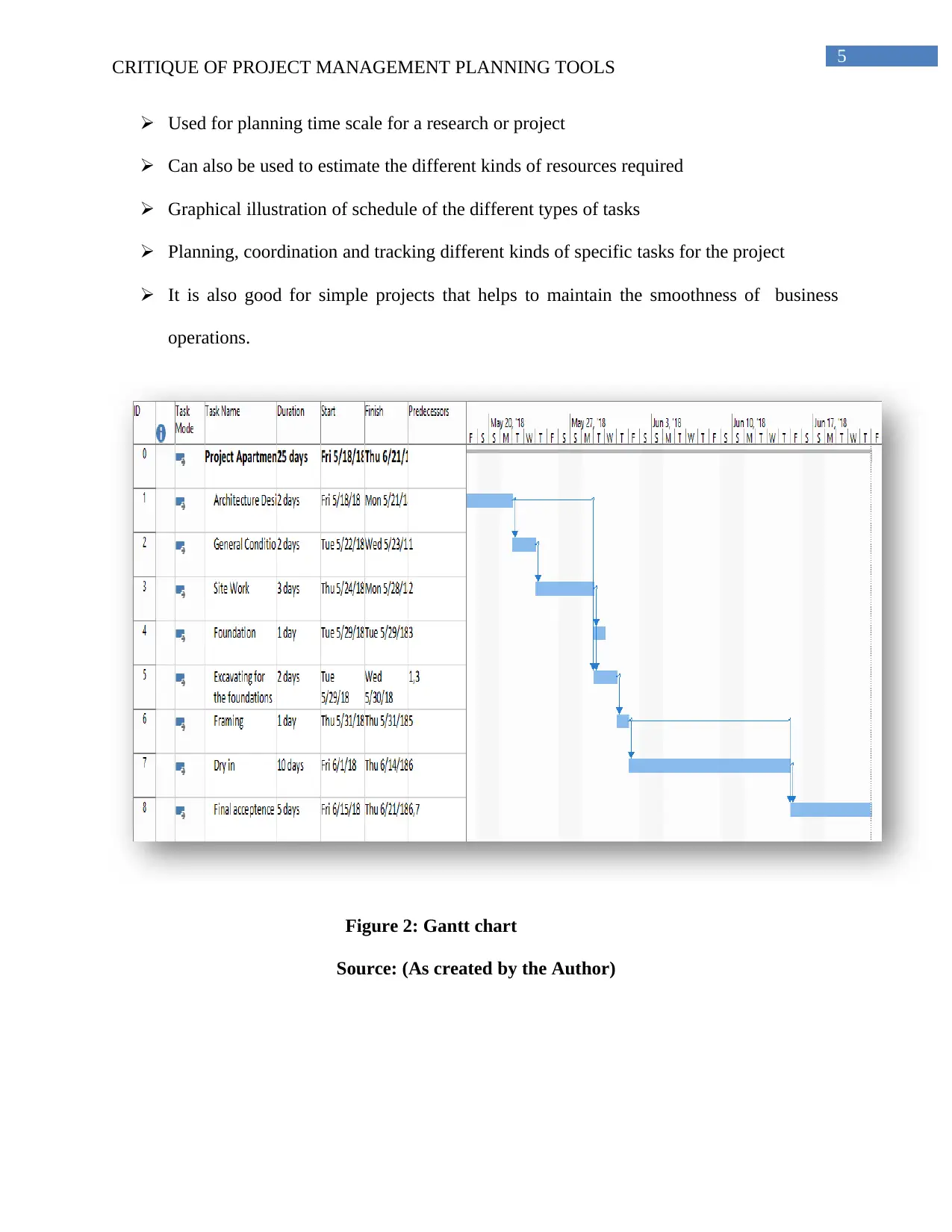
5
CRITIQUE OF PROJECT MANAGEMENT PLANNING TOOLS
Used for planning time scale for a research or project
Can also be used to estimate the different kinds of resources required
Graphical illustration of schedule of the different types of tasks
Planning, coordination and tracking different kinds of specific tasks for the project
It is also good for simple projects that helps to maintain the smoothness of business
operations.
Figure 2: Gantt chart
Source: (As created by the Author)
CRITIQUE OF PROJECT MANAGEMENT PLANNING TOOLS
Used for planning time scale for a research or project
Can also be used to estimate the different kinds of resources required
Graphical illustration of schedule of the different types of tasks
Planning, coordination and tracking different kinds of specific tasks for the project
It is also good for simple projects that helps to maintain the smoothness of business
operations.
Figure 2: Gantt chart
Source: (As created by the Author)
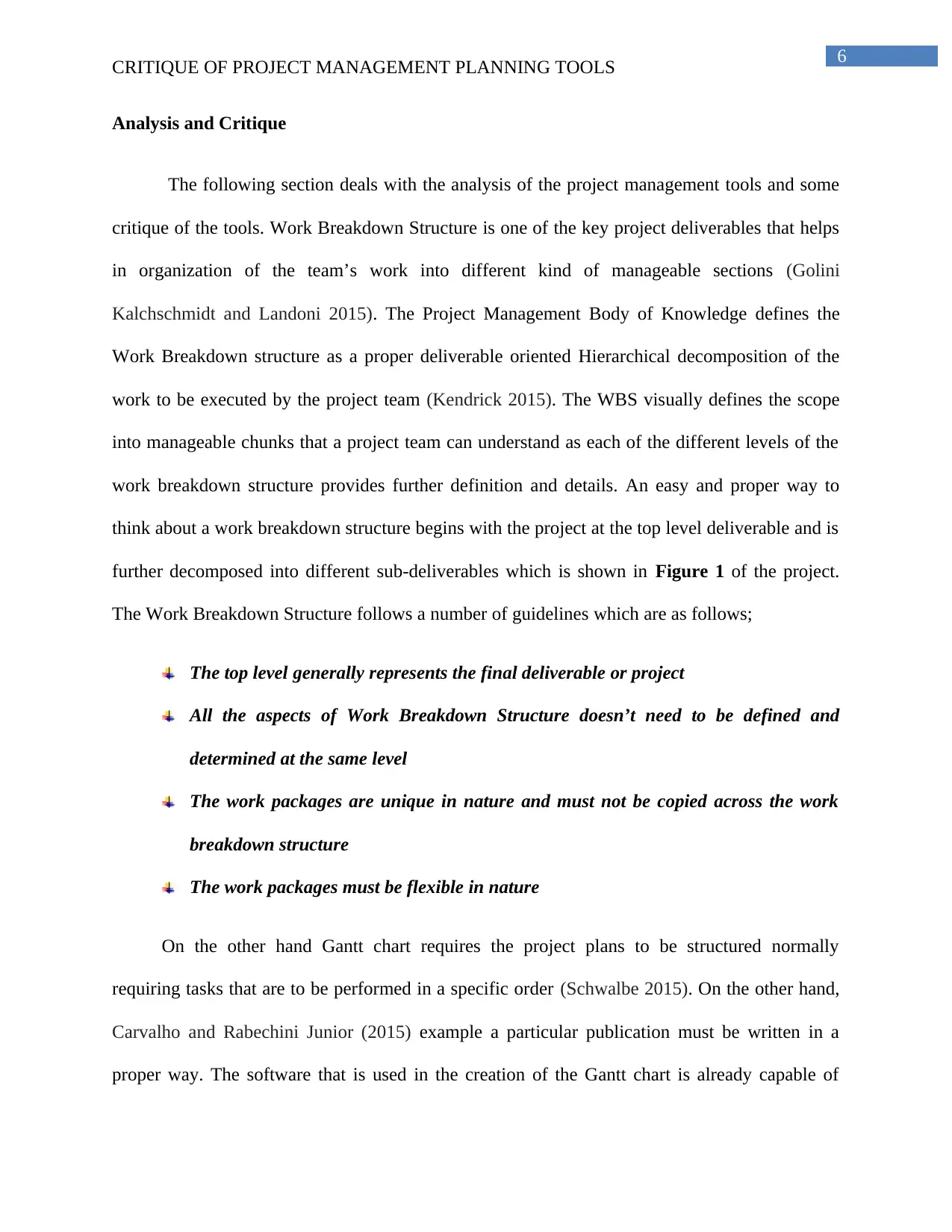
6
CRITIQUE OF PROJECT MANAGEMENT PLANNING TOOLS
Analysis and Critique
The following section deals with the analysis of the project management tools and some
critique of the tools. Work Breakdown Structure is one of the key project deliverables that helps
in organization of the team’s work into different kind of manageable sections (Golini
Kalchschmidt and Landoni 2015). The Project Management Body of Knowledge defines the
Work Breakdown structure as a proper deliverable oriented Hierarchical decomposition of the
work to be executed by the project team (Kendrick 2015). The WBS visually defines the scope
into manageable chunks that a project team can understand as each of the different levels of the
work breakdown structure provides further definition and details. An easy and proper way to
think about a work breakdown structure begins with the project at the top level deliverable and is
further decomposed into different sub-deliverables which is shown in Figure 1 of the project.
The Work Breakdown Structure follows a number of guidelines which are as follows;
The top level generally represents the final deliverable or project
All the aspects of Work Breakdown Structure doesn’t need to be defined and
determined at the same level
The work packages are unique in nature and must not be copied across the work
breakdown structure
The work packages must be flexible in nature
On the other hand Gantt chart requires the project plans to be structured normally
requiring tasks that are to be performed in a specific order (Schwalbe 2015). On the other hand,
Carvalho and Rabechini Junior (2015) example a particular publication must be written in a
proper way. The software that is used in the creation of the Gantt chart is already capable of
CRITIQUE OF PROJECT MANAGEMENT PLANNING TOOLS
Analysis and Critique
The following section deals with the analysis of the project management tools and some
critique of the tools. Work Breakdown Structure is one of the key project deliverables that helps
in organization of the team’s work into different kind of manageable sections (Golini
Kalchschmidt and Landoni 2015). The Project Management Body of Knowledge defines the
Work Breakdown structure as a proper deliverable oriented Hierarchical decomposition of the
work to be executed by the project team (Kendrick 2015). The WBS visually defines the scope
into manageable chunks that a project team can understand as each of the different levels of the
work breakdown structure provides further definition and details. An easy and proper way to
think about a work breakdown structure begins with the project at the top level deliverable and is
further decomposed into different sub-deliverables which is shown in Figure 1 of the project.
The Work Breakdown Structure follows a number of guidelines which are as follows;
The top level generally represents the final deliverable or project
All the aspects of Work Breakdown Structure doesn’t need to be defined and
determined at the same level
The work packages are unique in nature and must not be copied across the work
breakdown structure
The work packages must be flexible in nature
On the other hand Gantt chart requires the project plans to be structured normally
requiring tasks that are to be performed in a specific order (Schwalbe 2015). On the other hand,
Carvalho and Rabechini Junior (2015) example a particular publication must be written in a
proper way. The software that is used in the creation of the Gantt chart is already capable of
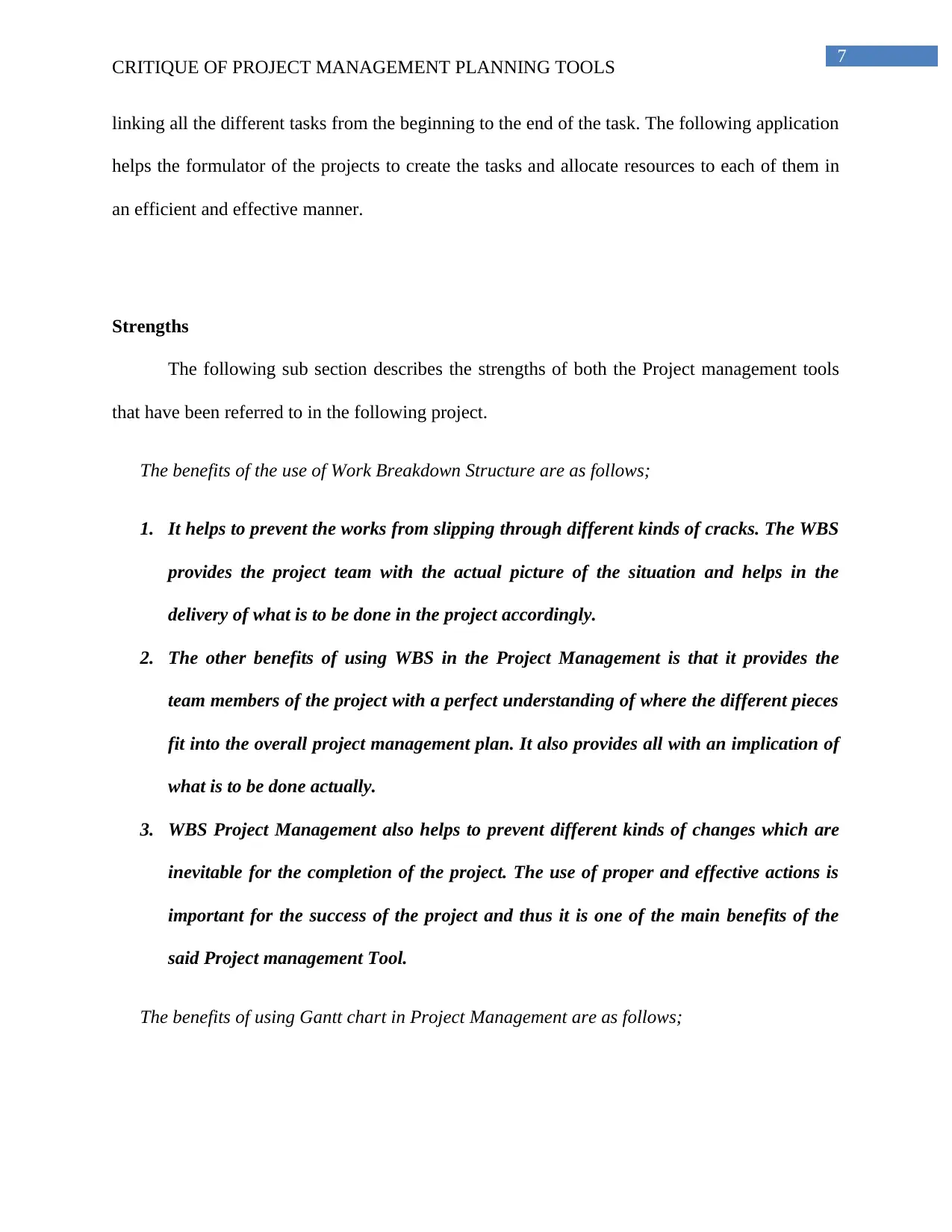
7
CRITIQUE OF PROJECT MANAGEMENT PLANNING TOOLS
linking all the different tasks from the beginning to the end of the task. The following application
helps the formulator of the projects to create the tasks and allocate resources to each of them in
an efficient and effective manner.
Strengths
The following sub section describes the strengths of both the Project management tools
that have been referred to in the following project.
The benefits of the use of Work Breakdown Structure are as follows;
1. It helps to prevent the works from slipping through different kinds of cracks. The WBS
provides the project team with the actual picture of the situation and helps in the
delivery of what is to be done in the project accordingly.
2. The other benefits of using WBS in the Project Management is that it provides the
team members of the project with a perfect understanding of where the different pieces
fit into the overall project management plan. It also provides all with an implication of
what is to be done actually.
3. WBS Project Management also helps to prevent different kinds of changes which are
inevitable for the completion of the project. The use of proper and effective actions is
important for the success of the project and thus it is one of the main benefits of the
said Project management Tool.
The benefits of using Gantt chart in Project Management are as follows;
CRITIQUE OF PROJECT MANAGEMENT PLANNING TOOLS
linking all the different tasks from the beginning to the end of the task. The following application
helps the formulator of the projects to create the tasks and allocate resources to each of them in
an efficient and effective manner.
Strengths
The following sub section describes the strengths of both the Project management tools
that have been referred to in the following project.
The benefits of the use of Work Breakdown Structure are as follows;
1. It helps to prevent the works from slipping through different kinds of cracks. The WBS
provides the project team with the actual picture of the situation and helps in the
delivery of what is to be done in the project accordingly.
2. The other benefits of using WBS in the Project Management is that it provides the
team members of the project with a perfect understanding of where the different pieces
fit into the overall project management plan. It also provides all with an implication of
what is to be done actually.
3. WBS Project Management also helps to prevent different kinds of changes which are
inevitable for the completion of the project. The use of proper and effective actions is
important for the success of the project and thus it is one of the main benefits of the
said Project management Tool.
The benefits of using Gantt chart in Project Management are as follows;
Paraphrase This Document
Need a fresh take? Get an instant paraphrase of this document with our AI Paraphraser
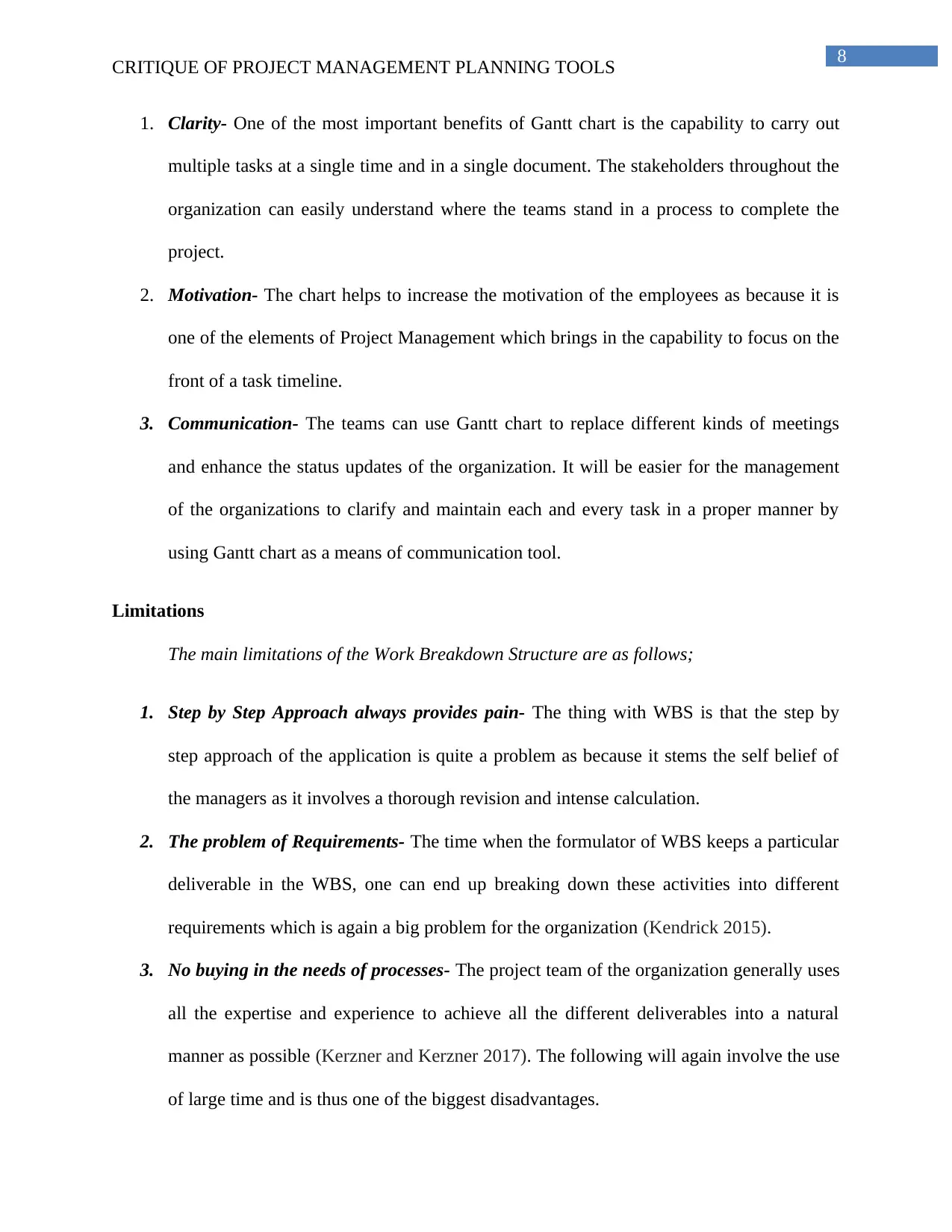
8
CRITIQUE OF PROJECT MANAGEMENT PLANNING TOOLS
1. Clarity- One of the most important benefits of Gantt chart is the capability to carry out
multiple tasks at a single time and in a single document. The stakeholders throughout the
organization can easily understand where the teams stand in a process to complete the
project.
2. Motivation- The chart helps to increase the motivation of the employees as because it is
one of the elements of Project Management which brings in the capability to focus on the
front of a task timeline.
3. Communication- The teams can use Gantt chart to replace different kinds of meetings
and enhance the status updates of the organization. It will be easier for the management
of the organizations to clarify and maintain each and every task in a proper manner by
using Gantt chart as a means of communication tool.
Limitations
The main limitations of the Work Breakdown Structure are as follows;
1. Step by Step Approach always provides pain- The thing with WBS is that the step by
step approach of the application is quite a problem as because it stems the self belief of
the managers as it involves a thorough revision and intense calculation.
2. The problem of Requirements- The time when the formulator of WBS keeps a particular
deliverable in the WBS, one can end up breaking down these activities into different
requirements which is again a big problem for the organization (Kendrick 2015).
3. No buying in the needs of processes- The project team of the organization generally uses
all the expertise and experience to achieve all the different deliverables into a natural
manner as possible (Kerzner and Kerzner 2017). The following will again involve the use
of large time and is thus one of the biggest disadvantages.
CRITIQUE OF PROJECT MANAGEMENT PLANNING TOOLS
1. Clarity- One of the most important benefits of Gantt chart is the capability to carry out
multiple tasks at a single time and in a single document. The stakeholders throughout the
organization can easily understand where the teams stand in a process to complete the
project.
2. Motivation- The chart helps to increase the motivation of the employees as because it is
one of the elements of Project Management which brings in the capability to focus on the
front of a task timeline.
3. Communication- The teams can use Gantt chart to replace different kinds of meetings
and enhance the status updates of the organization. It will be easier for the management
of the organizations to clarify and maintain each and every task in a proper manner by
using Gantt chart as a means of communication tool.
Limitations
The main limitations of the Work Breakdown Structure are as follows;
1. Step by Step Approach always provides pain- The thing with WBS is that the step by
step approach of the application is quite a problem as because it stems the self belief of
the managers as it involves a thorough revision and intense calculation.
2. The problem of Requirements- The time when the formulator of WBS keeps a particular
deliverable in the WBS, one can end up breaking down these activities into different
requirements which is again a big problem for the organization (Kendrick 2015).
3. No buying in the needs of processes- The project team of the organization generally uses
all the expertise and experience to achieve all the different deliverables into a natural
manner as possible (Kerzner and Kerzner 2017). The following will again involve the use
of large time and is thus one of the biggest disadvantages.
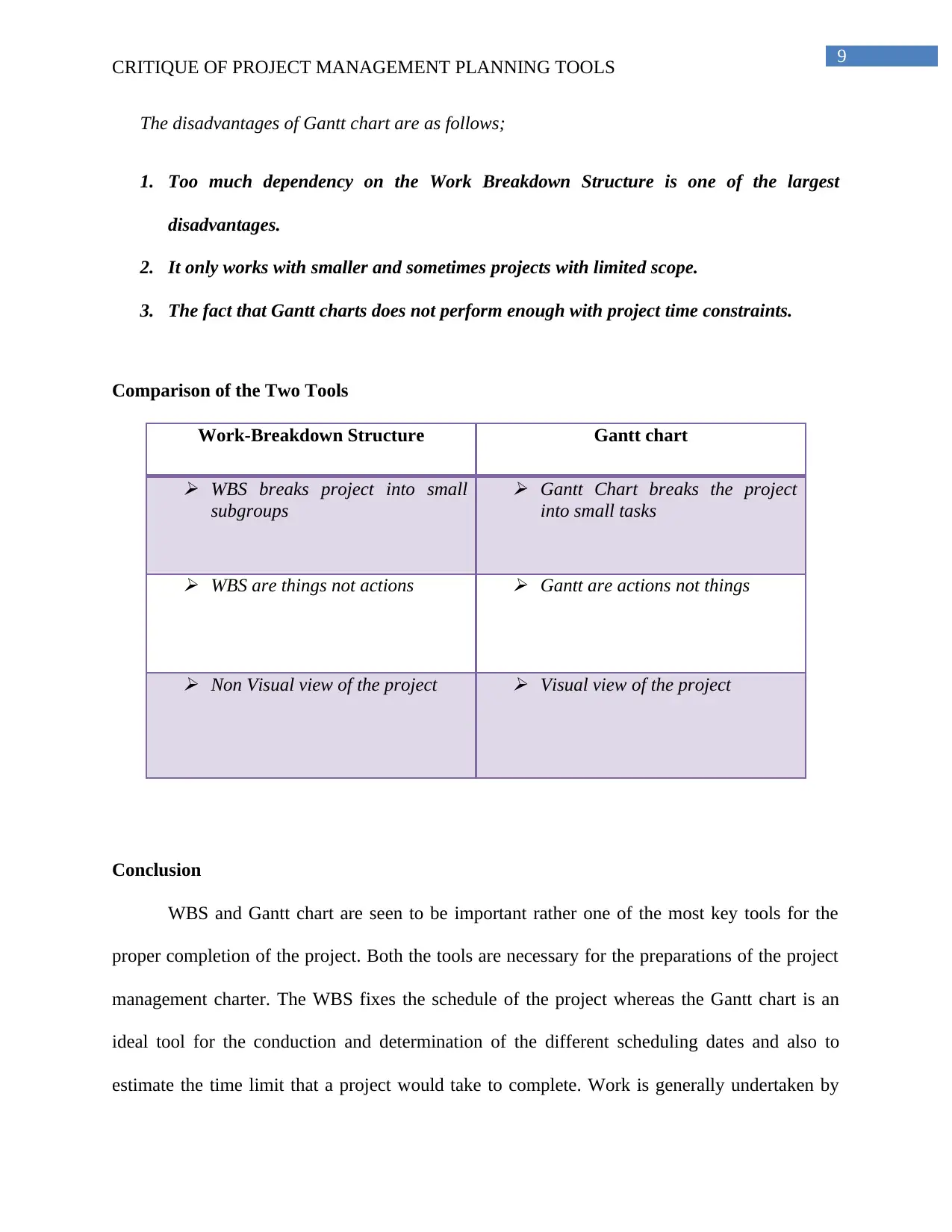
9
CRITIQUE OF PROJECT MANAGEMENT PLANNING TOOLS
The disadvantages of Gantt chart are as follows;
1. Too much dependency on the Work Breakdown Structure is one of the largest
disadvantages.
2. It only works with smaller and sometimes projects with limited scope.
3. The fact that Gantt charts does not perform enough with project time constraints.
Comparison of the Two Tools
Work-Breakdown Structure Gantt chart WBS breaks project into small
subgroups
Gantt Chart breaks the project
into small tasks
WBS are things not actions
Gantt are actions not things
Non Visual view of the project
Visual view of the project
Conclusion
WBS and Gantt chart are seen to be important rather one of the most key tools for the
proper completion of the project. Both the tools are necessary for the preparations of the project
management charter. The WBS fixes the schedule of the project whereas the Gantt chart is an
ideal tool for the conduction and determination of the different scheduling dates and also to
estimate the time limit that a project would take to complete. Work is generally undertaken by
CRITIQUE OF PROJECT MANAGEMENT PLANNING TOOLS
The disadvantages of Gantt chart are as follows;
1. Too much dependency on the Work Breakdown Structure is one of the largest
disadvantages.
2. It only works with smaller and sometimes projects with limited scope.
3. The fact that Gantt charts does not perform enough with project time constraints.
Comparison of the Two Tools
Work-Breakdown Structure Gantt chart WBS breaks project into small
subgroups
Gantt Chart breaks the project
into small tasks
WBS are things not actions
Gantt are actions not things
Non Visual view of the project
Visual view of the project
Conclusion
WBS and Gantt chart are seen to be important rather one of the most key tools for the
proper completion of the project. Both the tools are necessary for the preparations of the project
management charter. The WBS fixes the schedule of the project whereas the Gantt chart is an
ideal tool for the conduction and determination of the different scheduling dates and also to
estimate the time limit that a project would take to complete. Work is generally undertaken by
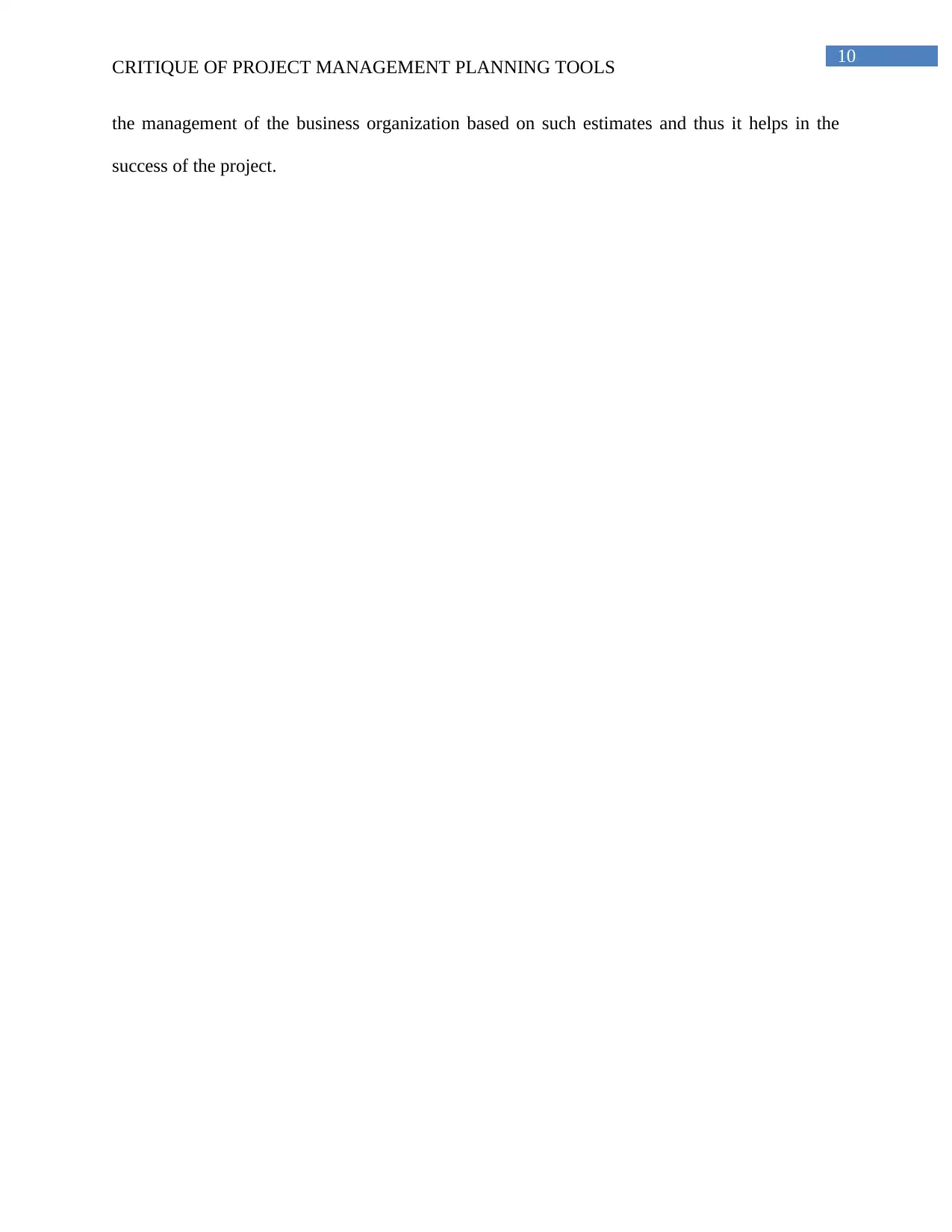
10
CRITIQUE OF PROJECT MANAGEMENT PLANNING TOOLS
the management of the business organization based on such estimates and thus it helps in the
success of the project.
CRITIQUE OF PROJECT MANAGEMENT PLANNING TOOLS
the management of the business organization based on such estimates and thus it helps in the
success of the project.
Secure Best Marks with AI Grader
Need help grading? Try our AI Grader for instant feedback on your assignments.
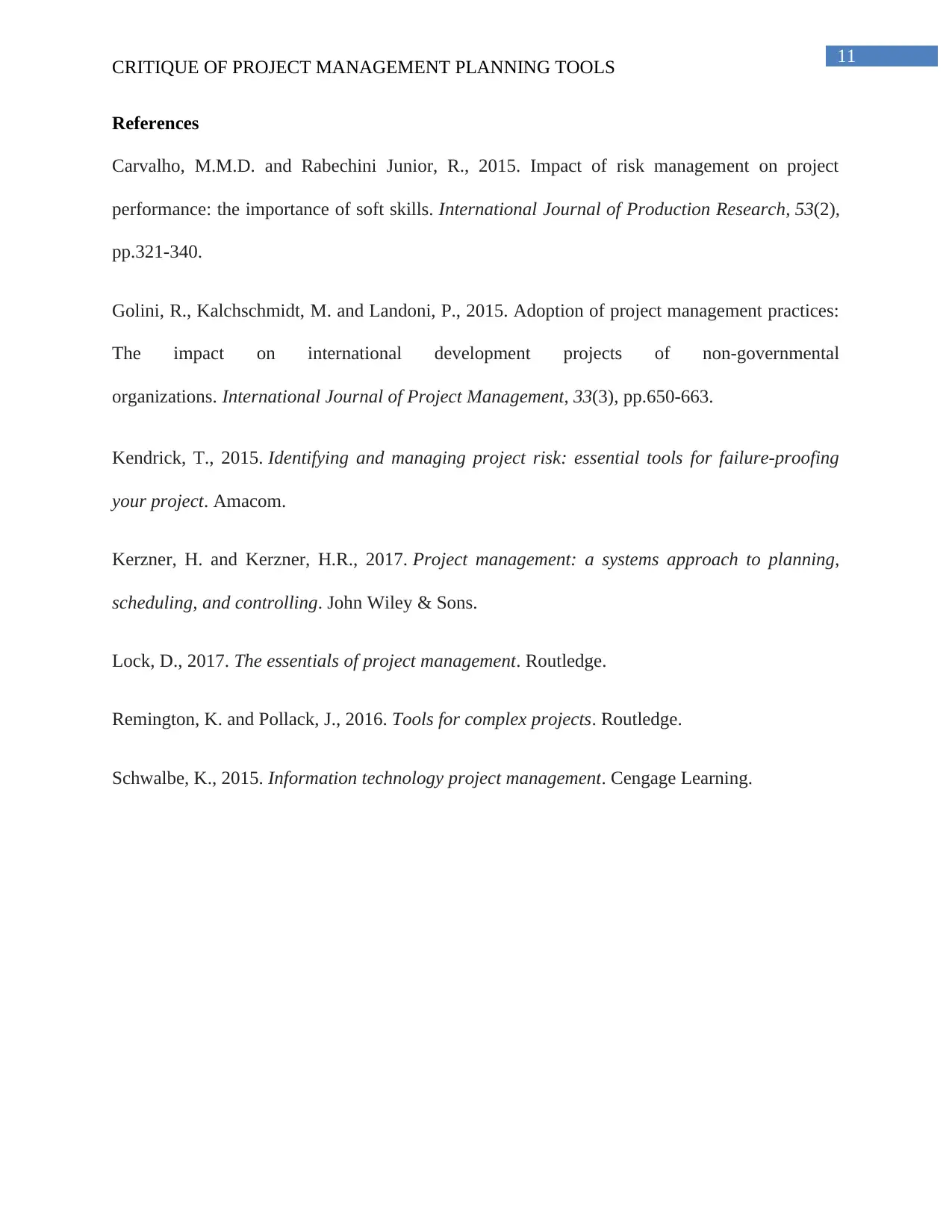
11
CRITIQUE OF PROJECT MANAGEMENT PLANNING TOOLS
References
Carvalho, M.M.D. and Rabechini Junior, R., 2015. Impact of risk management on project
performance: the importance of soft skills. International Journal of Production Research, 53(2),
pp.321-340.
Golini, R., Kalchschmidt, M. and Landoni, P., 2015. Adoption of project management practices:
The impact on international development projects of non-governmental
organizations. International Journal of Project Management, 33(3), pp.650-663.
Kendrick, T., 2015. Identifying and managing project risk: essential tools for failure-proofing
your project. Amacom.
Kerzner, H. and Kerzner, H.R., 2017. Project management: a systems approach to planning,
scheduling, and controlling. John Wiley & Sons.
Lock, D., 2017. The essentials of project management. Routledge.
Remington, K. and Pollack, J., 2016. Tools for complex projects. Routledge.
Schwalbe, K., 2015. Information technology project management. Cengage Learning.
CRITIQUE OF PROJECT MANAGEMENT PLANNING TOOLS
References
Carvalho, M.M.D. and Rabechini Junior, R., 2015. Impact of risk management on project
performance: the importance of soft skills. International Journal of Production Research, 53(2),
pp.321-340.
Golini, R., Kalchschmidt, M. and Landoni, P., 2015. Adoption of project management practices:
The impact on international development projects of non-governmental
organizations. International Journal of Project Management, 33(3), pp.650-663.
Kendrick, T., 2015. Identifying and managing project risk: essential tools for failure-proofing
your project. Amacom.
Kerzner, H. and Kerzner, H.R., 2017. Project management: a systems approach to planning,
scheduling, and controlling. John Wiley & Sons.
Lock, D., 2017. The essentials of project management. Routledge.
Remington, K. and Pollack, J., 2016. Tools for complex projects. Routledge.
Schwalbe, K., 2015. Information technology project management. Cengage Learning.
1 out of 11
Related Documents
Your All-in-One AI-Powered Toolkit for Academic Success.
+13062052269
info@desklib.com
Available 24*7 on WhatsApp / Email
![[object Object]](/_next/static/media/star-bottom.7253800d.svg)
Unlock your academic potential
© 2024 | Zucol Services PVT LTD | All rights reserved.




